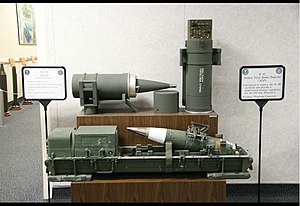W82
| W82 | |
|---|---|
 Diagram of the XM785 shell and W82 warhead. | |
| Type | Nuclear warhead |
| Place of origin | United States |
| Production history | |
| Designer | Lawrence Livermore Laboratory |
| Specifications | |
| Mass | 43 kg (95 lb) |
| Length | 860 mm (34 in) |
| Blast yield | 2 kt (8.4 TJ) |

TheW82(also known as theXM785shell) was a low-yieldtactical nuclear warheaddeveloped by the United States and designed to be used in a155 mmartillery shell. It was conceived as a more flexible replacement for theW48,the previous generation of155 mmnuclear artilleryshell. A previous attempt to replace the W48 with theW74 munitionwas canceled due to cost.
Originally envisioned as adual-purpose weapon,with interchangeable components to allow the shell to function as either astandardfission explosive or anenhanced radiationdevice, the warhead was developed atLawrence Livermore Laboratory[1]starting in 1977. The eventual prototype round had a yield of 2kt(8.4TJ) in a package 34 inches (860 mm) long and weighing 95 pounds (43 kg),[1]which included therocket-assistedportion of the shell. The unit cost of the weapon was estimated atUS$4million.[2]: 93 Although enhanced radiation devices were considered more effective at blunting an invasion due to the high neutron flux they produce, the more complex design eventually led to the cancellation of the dual-purpose W82-0 program in 1982. Development of astandardweapon, the W82-1, was restarted in 1986. The program was finally cancelled in 1991 due to the end of theCold War.
Design
[edit]The shell used a body made from titanium with a copper rotating band. A special process was developed to bond the rotating band to the titanium body of the shell which prevented shell-band separation during firing.[3]
References
[edit]- ^ab"W82 / XM-785".GlobalSecurity.org.30 September 2018.Archivedfrom the original on 25 January 2022.Retrieved13 February2021.
- ^Schwartz, Stephen I. (1 June 1998).Atomic Audit: The Costs and Consequences of U.S. Nuclear Weapons Since 1940.Brookings Institution Press.ISBN978-0815777748.LCCN98019746.OCLC1120391883.OL8050319M.Archivedfrom the original on 15 February 2023.Retrieved8 July2021– viaGoogle Books.
- ^Improved Bonding of Copper Rotating Bands to Titanium Artillery Shells(Poster). Watertown Arsenal, US Army.Archivedfrom the original on 2022-06-30 – via National Archives at Boston, Box 12, Folder: Prints & Negatives, 1980-1984.
Further reading
[edit]- Hansen, Chuck, "Swords of Armageddon:U.S. Nuclear Weapons Development since 1945 "(CD-ROM & download available). PDF-2.67 Mb. 2,600 pages, Sunnyvale, California, Chucklea Publications, 1995, 2007.ISBN978-0-9791915-0-3(2nd Ed.)
